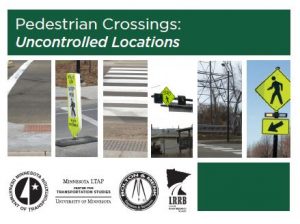This guidebook was developed to help Minnesota transportation agencies evaluate their uncontrolled pedestrian crossings and determine appropriate treatment options. The guidebook recommends when to install marked crosswalks and other enhancements at uncontrolled locations based on a number of factors, including the average daily vehicle count, number of pedestrians, number of lanes, and average vehicle speed. It helps agencies rate a crossing for pedestrian service, and it includes a flow chart and several worksheets to assist in data collection and decision making.
When using the guidebook, practitioners are guided through an 11-step evaluation process. Based on the results of the evaluation, users can identify what level of treatment is appropriate for their location, ranging from in-street crossing signs to overhead flashing beacons to traffic calming devices such as curb bump-outs. For each potential treatment option, the guidebook includes information on advantages, disadvantages, recommended locations, and cost.
The evaluation methodology used in the guidebook is based on research on the safety of pedestrian crossings and the procedure developed in the 2010 Highway Capacity Manual. It also considers best practices in pedestrian crossing evaluation by the Federal Highway Administration, the Minnesota Department of Transportation, the American Association of State Highway and Transportation Officials, the Transportation Research Board, and others. The information is intended to offer agencies a consistent methodology for evaluating uncontrolled pedestrian crossing locations on their roadways.
The data collection worksheets featured in the guidebook are also available for download as Excel spreadsheets, which automatically complete the evaluation calculations based on entered data.
The development of the guidebook was funded by the Minnesota Local Road Research Board.
- Pedestrian Crossings: Uncontrolled Locations (Guidebook)
- Data collection worksheets (XLS)
- Full research report (Uncontrolled Pedestrian Crossing Evaluation Incorporating Highway Capacity Manual Unsignalized Pedestrian Crossing Analysis Methodology)
- Technical Summary